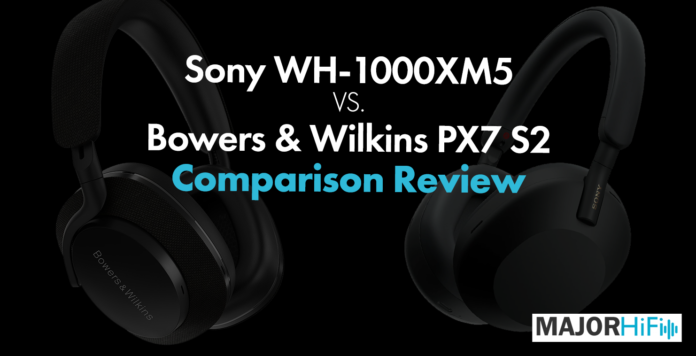2022 has seen the release of a few new Bluetooth headphones. The Sony WH-1000XM5 and Bowers & Wilkins PX7 S2 are both continuations of ongoing mainline series that have been met with great acclaim. I have taken a look at both headphones, and they set a certain standard for others to meet, but which one is the best?
What You Get
| Sony WH-1000XM5 | Bowers & Wilkins PX7 S2 |
|
|
Look and Feel
The XM5 and PX7 S2 both underwent design changes from their last iterations. Both headphones actually follow a similar build, with large earcups and a thinner headband. I see the XM5 to be a great improvement stylistically over the XM3 and XM4, but the PX7 S2 easily has it beat. Not only is the comfort superior, but the construction is far sleeker, especially the blue variation I tested, which had a very fashionable appearance.
Design and Functionality
Both headphones have a good amount of features, with companion apps acting as a hub for those features. ANC is present on both headphones and is effective in similar ways. However, Sony gets the leg up for its adaptive ANC, which is still the strongest out of any Bluetooth headphone on the market. They are also similarly reliable with their touch control responsiveness, as I never had an issue getting either to work. Sony has a ton more features than the PX7 S2, and even the ones they share like EQ is still more expanded on Sony’s model.
Bluetooth and Battery Life
These headphones both have a fast and easy pairing that is almost instantaneous. Sony gets points for supporting LDAC, but aptX adaptive for the PX7 S2 isn’t far behind. Both headphones should give you 30 hours of playtime with one complete charge.
Soundstage
If I were just comparing the default soundstage of both headphones, the PX7 S2 would run away with it. However, Sony’s 360 Reality Audio feature complicates things, bringing spatial audio effectiveness into the conversation. While the PX7 S2 doesn’t have any spatial audio features, the standard soundstage of the headphones is naturally good, with effective instrumental separation that feels realistic and clear. The XM5 has a similar level of accuracy, but the individual sound elements aren’t as easily identifiable. They also are both very in-your-head, not showing a ton of open headspace, but with spatial audio, the XM5 is able to present a more immersion through its object-based imaging. The PX7 S2 is much more traditional with its stereo imaging but offers less cloudiness and more air in-between spaces.
Low End
In terms of impact, both the XM5 and the PX7 S2 offer a great amount of thickness in their bass. They have a ton of weight in their frequency content, resulting in a meaty response that strongly favors the low end of the spectrum in a fun and engaging way. You won’t find the most detail in either timbre, especially with the XM5’s excessive boominess without EQ, but it does bring a level of energy that makes these such wireless powerhouses.
EQ can make each bass response even more varied, but Sony’s Clear Bass option has a lot more to bring to the sound signature than the more limited bass leveler in Bower’s and Wilkins’s own companion app. With the XM5, the bass can sound dramatically different depending on where you set the Clear Bass leveler and EQ, whereas the PX7 S2 can only adjust a limited range of bass frequency gain.
Mids
Neither headphone is particularly strong in its midrange response, but the PX7 S2 is noticeably more clean in its timbre than the XM5. Even with EQ, the XM5 is still a little too muddy in the low-mids, but there’s still a better balance here than in other 1000X models. With the PX7 S2, the mids aren’t as present, but the details that come through are quite clean and resolving. Some midrange bands help excite the sound signature on the S2, but the XM5 keeps an even balance of midrange accuracy throughout. I much prefer the roomier and clear presentation of the PX7 S2 than the slightly bloated shape the mids take on the XM5, however with EQ the XM5 is a lot more versatile.
Highs
Both headphones have more to offer in their treble than a lot of other Bluetooth headphones. I thought the XM5 showed some great improvement toward their default treble timbre, and of course, EQ can make the highs better for your taste. The PX7 S2 also has some nice highs that are smooth and flavorful. They have more natural qualities than the XM5, which can sound artificial at times.
Summary
There are many reasons why you might like the XM5 over the PX7 S2, but when it comes to pure sound quality, the latter is one of the best currently on the market. It isn’t perfect, but clarity means a lot to a bass-heavy Bluetooth headphone, and the PX7 S2 handles its sound signature in an effective manner. The XM5 still has a lot of great qualities, particularly in its bass and spatial audio, but without EQ the sound signature is still a bit too hazy for my tastes. However, the 1000x series is still the best when it comes to pure noise-canceling tech. Both options are still great picks with many different uses and are the best in the market for a reason.
The Sony WH-1000XM5 and Bowers & Wilkins PX7 S2 are available at Audio46.
Compare the ranking of various headphones, earbuds and in-ear monitors using our tools.
Discuss this, and much more, over on our forum.
---MAJORHIFI may receive commissions from retail offers.















